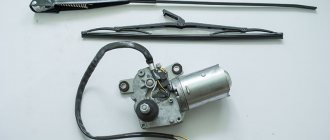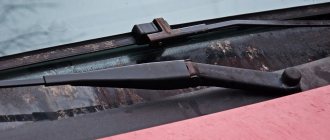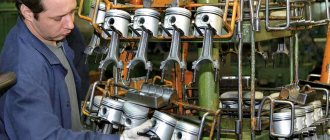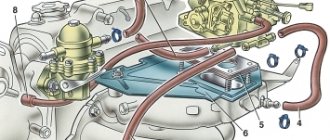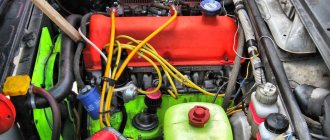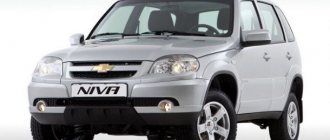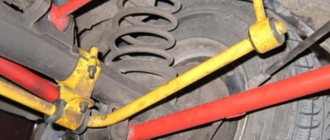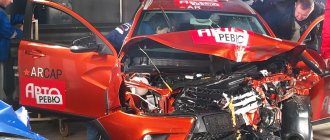VAZ 2109 (popularly called “nine”) is a Soviet front-wheel drive vehicle of group II small class in a hatchback body. The model was developed and mass-produced at the Volzhsky Automobile Plant from 1987-2004.
From 2004, cars (VAZ-21093) until the end of 2011 were assembled from vehicle kits at the Ukrainian enterprise ZAZ. This vehicle is also a five-door version of the VAZ-2108 in the Lada Sputnik model division. You can still buy this car on the used car market today. The entire Lada model range.
Car history
Towards the end of the 1980s, AVTOVAZ decided to fill the empty niche of comfortable and versatile family models with the VAZ-2109 car. The fact that the debut domestic mass-produced front-wheel drive car appeared at the Volga Automobile Plant was a significant event not only for the Volga residents, but also for the entire Soviet automobile industry.
It’s a little symbolic, but the start of production of the G8 coincided with a significant event that was celebrated in the fall of 1984 - the 60th anniversary of the automobile industry of the Union of Soviet Socialist Republics. After two years, the original assembly line of the car plant in Togliatti produced a pilot batch of 159 Nine models.
The new version of the “chisel” inherited all the technical innovations from the older model and was able to instantly gain the respect of car lovers. Among all the points, the most important was the “rational” number of doors. However, despite this, a three-door version entered mass production. The logical question arises, why?
Because in a state where personal transport was considered a luxury, and happy car owners felt the transport difficulties of their relatives and friends, the standard 3-volume sedan version was more suitable to the needs of drivers. For a long time, all Soviet mass-produced cars were produced in just such a body.
More productive station wagons, which were produced in small quantities, began to be sold only towards the end of the 1960s, and they were considered in great short supply. There was not a word about other versions of the body: directors of automobile enterprises did not even risk conducting experiments, objectively believing that these programs would not be positively received “at the top.”
But in the case of the G8, everything turned out in the opposite order. At the end of the 1970s, all of Europe was literally overwhelmed by the fashion for hatchbacks. The leaders of the Tolyatti automobile plant, wanting to comply with modern trends, during the design of the new model series, decided to introduce into it, in addition to the standard sedan, 3- and 5-door hatchbacks that were fundamentally fresh for Soviet industrial turnover.
The entry into the foreign market of a new car, designed in accordance with the standards of global trends, was supposed to strengthen VAZ's export positions. The Ministry of Automotive Industry cooled down the ardor of the engineers from Tolyatti a little, calculating the impossibility of financing the production of all 3 versions for assembly line assembly.
In reality, it was possible to free only one line of the factory conveyor for the assembly of 2 standardized modifications. As it turned out, the role of those “lucky ones” was a hatchback, which had a lot of common body elements. As the base version, they decided to choose a cheaper three-door car, and a couple of years later, a five-door car “came to the rescue.”
The sedan version (VAZ-21099) was introduced into mass production only at the end of 1990. Although this delay in a sense benefited the enterprise itself, since with the appearance of the sedan there would have been intense competition with the hatchback version, which was in no way included in the plans of the management of the Volzhsky Automobile Plant.
Checkpoints
Measuring the distances between body control points is the most common way to check the condition of a car. After taking measurements, you need to check them with the passport data.
The check is performed as follows:
- Dimensions are checked diagonally;
- The current condition of the machine racks is checked;
- The roof is examined visually, the dimensions of the diagonals of the roof itself and the door frame are checked;
- Increased attention is paid to measurements of the rear and front window frames;
- A visual inspection of the entire body is carried out from various angles in order to determine the presence of gaps and bulges that differ from the required parameters.
| Check Point | Passport sizes | Tolerance (+/-) |
| Diagonal of the front doorway from the edge of the lower threshold to the middle of the roof | 1345 millimeters | 5 millimeters |
| Diagonal of the front door opening from the lowest point of the windshield to the middle of the lower threshold | 1000 millimeters | 5 millimeters |
| Distance between front door hinges and pillar in a straight line | 963 millimeters | 5 millimeters |
| Diagonal of the rear door opening from the point where the lower sill joins the central door pillar to the roof | 1112 millimeters | 5 millimeters |
| Diagonal of the rear door opening from the top of the B-pillar to the lower threshold | 860 millimeters | 5 millimeters |
| Long diagonal rear side window frame | 706 millimeters | 3 millimeters |
| Short diagonal rear side window frame | 383 millimeters | 3 millimeters |
| Hood diagonal | 1610 millimeters | 5 millimeters |
| Distance from the middle of the windshield to the middle of the hood | 712 millimeters | 5 millimeters |
Appearance
From the outside, the VAZ-2109 is an evolution of the Soviet car. Here you can notice the transition to rectangular body lines, which are clearly distinguished by the bow headlights, which are shaped like a trapezoid, as well as a flat-shaped radiator grille and a slightly inclined hood. It was decided to place the turn signal lights on the long front fenders.
After some time, hydraulic headlight range control began to be installed on all “nines”, and some vehicles had a brush headlight cleaner. In 1989, the debut restyling of the “nine” exterior took place, which consisted of a transition from small front wings to longer ones. The most dubious component in the exterior of the G8 and VAZ-2109 was the so-called nasal mask.
It was a fairly complex type of body part, which was adjacent to the hood and wings installed in front. The combined mask area had a beak that protruded forward of the radiator trim. Block headlights were installed on the sides of this unusual structure. Such a pile of elements reduced the already slight elegance of the Soviet car, and the clear lines connecting the cladding to the wings looked unpleasant.
We decided to use only a solid wing, without any “tricks,” which improved the appearance of the VAZ 2109. After this, they installed a new grille, which had two longitudinal stripes in a large frame. After some time, they began to use a new version, consisting of 3 massive stripes, devoid of any frame.
VAZ-2109 with an updated radiator grille
The side part has the same straight lines of doors and roof, wheel arches and average ground clearance. “Nine” is very similar to its predecessor, the VAZ-2108, which was nicknamed “chisel”. The Soviet hatchback has the same nose shape. Unusually large doors and a thick central pillar add “sporty features” to the model.
On the “nine”, the width of the doors installed in front was reduced from 1,264 to 1,025 millimeters. Thanks to this, the design team was able to incorporate rear doors into the side of the body, the width of which is 885 millimeters. The rectangular rear lights are limited by the line of the luggage compartment lid, which also has a sharp transition at an angle to the roof.
The fifth door received a rear window with a wiper, and the bumpers, along with the side skirts, were made of black plastic (there is a similar bumper in front). The design of the VAZ 2109 has a certain swiftness of lines, but it is very far from a sports car.
Here the developers placed great emphasis on the more practical aspects of the vehicle. When 1987 arrived, the new model mastered the production of plastic gas tanks, which were much lighter and easier to assemble than others. VAZ-2108 and VAZ-2109 already had gas tanks made of steel and plastic.
It is worth admitting that after a while they decided to abandon the production of plastic tanks, as there were problems with the permeability of gasoline vapors.
Exterior
Although the Eight and Nine have similar dimensions and a very similar design, conceptually they are completely different cars. The appearance of the 9th model still retains its swift features, but all the “hints of sportiness” have given way to practicality.
VAZ-2109
VAZ-2109 was distinguished by a new front part of the body, less massive front doors, an updated radiator grille and solid side wings. Because of the wedge-shaped body shape, it, like the related “eight”, was given the nickname “chisel” by the people.
“Nine”
In 1991, “Sputnik” underwent restyling, as part of which it got rid of the plastic edging of the front end. The car acquired “long wings” and a “traditional” radiator grille lining.
Interior
The interior decoration of the VAZ is reminiscent of the minimalism of the 1980s. The instrument panel and dashboard create an almost right angle. There are only 3 types of panels: “low”, “high” and “European”. If we talk about the quality of the plastic used as finishing, then it is far from ideal.
Of course, by installing plastic in the interior of the Nine, it was possible to reduce the weight of the car, but on the other hand, it deprived VAZ cars of that touch of luxury that the Zhiguli of the classic division is remembered for. If you look at it differently, the ergonomic level is not bad, so you don’t have to be distracted from driving the vehicle on the road.
This was partly achieved through the compact arrangement of controls. Inside the steering wheel there is one curved cross member with a horn button. Airbags are not provided by the factory. In general, the interior of the VAZ-2109 is purely practical with claims to the level of comfort.
Despite the laconic “low” instrument panel, it is quite comfortable. Although many liked the high panel 2109. The seats installed in front received headrests. In addition, the front seats have upper seat belt attachment points that are height adjustable.
The elastic seats provide good body support. But a tall driver will lack the choice of adjusting his seat in the longitudinal plane. The rear sofa, although designed for three passengers, can only accommodate two people comfortably.
Do not forget that their height should be no more than 175 cm. The luggage compartment volume of the Soviet hatchback is quite modest 270 liters of usable space (the more practical platform version already received 400 liters).
Test drive your Nine - what to look for?
If you have already chosen a specific copy on the car market or on an advertisement site, do not rush to give the owner money. First, get into the car and drive it. Most likely, you will get answers to all the basic questions on the go. If the car is decent, then it will be pleasant to drive and will not make you cover your ears from unnecessary noise or be afraid of terrible vibrations. If the car is already reaching its end of life, the trip will not bring any pleasure.
Pay special attention to the following features:
- engine operation - the engine is usually audible in the cabin even with good sound insulation, but in general the machine does not make you cringe at the terrible sounds in the cabin, this should alert the buyer;
- howling gearbox - at high mileage or in the absence of good maintenance, the gearbox begins to howl, crackle and shift poorly, its repair is not difficult, but this factor indicates the condition of the car;
- knocking in the suspension - the chassis of the Nine is assembled well and competently, so the car should be more or less smooth when driving, there are no unpleasant knocks on uneven surfaces;
- taxiing - the VAZ 2109 steers well, practically not inferior in this indicator to its foreign competitors of those years, so any problems should alert the owner of the car;
- the operation of the pedals and the response of the car, as well as the appearance of various malfunction signals on the control panel, this does not always indicate a breakdown, but it should alert you.
VAZ 2109 buyers do not always go to a service station and spend extra money on checking the vehicle. But it's still worth doing. In the car you can look at the condition of the body, check the operation of the units with the help of a technician, and make sure that the electrical part is working properly. It’s better to spend a few hundred more rubles, but make sure that the car is of normal quality and has decent parameters. Otherwise, you can buy a pig in a poke and a set of problems.
Technical characteristics of VAZ 2109
Engine
In the role of motors, domestic engineers used various power plants with different volumes and power. The very first Soviet-made models came with a 1.1-liter engine.
The basic version of the “nine” was equipped with a 4-stroke, eight-valve, four-cylinder power unit of the “eight”, the displacement of which was 1,295 cubic centimeters. This “engine” developed 64 horsepower at 5,600 rpm. Peak torque (94 Nm) reached after 3,400 rpm.
The speed limit was 148 kilometers per hour. The first hundred was reached in 16 seconds. Such a modest engine consumed about 8.7 liters per hundred kilometers in city mode and 5.7 liters outside the city.
Option 21093 already has a carburetor engine 21083. It has a volume of 1,499 cubic centimeters. Maximum power of 69 “horses” is achieved after reaching 5,600 rpm. The maximum torque is 106.4 Nm already at 3,500 rpm. The Soviet hatchback can accelerate to 155 kilometers per hour, and the first hundred is reached in 15 seconds.
It is logical to conclude that as power increases, gasoline consumption also increases. So, in the city this figure remains at 8.6 liters per hundred kilometers, and on the highway it drops to 5.9 liters per 100 kilometers. The VAZ 2109 carburetor was called “Solex” and was a new, more economical model.
The most compact is considered to be the 1.1-liter engine, developing only 54 “horses”, which were available at 5,600 rpm. Maximum torque of 79 Nm is available at 3,600 rpm. The maximum speed does not exceed 155 kilometers per hour, and fuel consumption in combined mode is about 6.7 liters per 100 kilometers.
In addition, later they began to produce the VAZ 2109 engine with an injector. It received the index 211180 and was installed in the VAZ-21093i and 1.5 liter volume. This power unit is capable of producing 72 horsepower, available at 5,600 rpm.
Peak torque of 118 Nm is available at 2,800 rpm. For every 100 kilometers, the fuel consumption of the VAZ 2109 is 8.0 liters in the city and 5.8 liters on the highway.
In the injection version of the engine, injectors very often fail, but you can repair them yourself or have them repaired by specialists. This video explains well how to clean and rinse the injectors yourself.
Transmission
The gearbox for the hatchback initially came with four speeds, but since 1989, the engineering staff decided to introduce a five-speed manual transmission. This transmission has a single-plate simple clutch, a cylindrical final drive, a bevel differential and drive shafts with CV joints.
There is also an integrated center spring and cable drive. The VAZ 2109 gearbox is not very complicated, so some even undertake to repair it on their own.
The design of the Soviet front-wheel drive hatchback has an interesting feature. In order to engage reverse gear, move the gearshift lever all the way to the left and forward. Almost the same principle applies to turning on the first speed.
Chassis
At the front, they decided to install a fully independent McPherson-type suspension, which is also called a “floating spark plug.” At the rear they installed a semi-independent suspension with a transverse beam that works on torsion.
In its structure, such a beam is similar to numerous front-wheel drive cars of past years. Hydraulic shock absorbers, cylindrical springs, as well as lower wishbones with braces and a stabilizer bar are used.
As a braking device for a front-wheel drive car, disc brakes with movable calipers in front and drum mechanisms in the rear are used. The distance between the disc and the pad is adjusted automatically. The brake drive of the machine is represented by the hydraulic method.
Safety
The dashboard takes impacts tightly. The controls, along with the headrests and other elements, were made of soft plastic. The factory provided sun visors, so as not to blind the driver, which were covered with cladding. Additional sun protection is provided by easily adjusting the placement of the interior mirror.
The plant workers provided a system of mutually moving elements that absorb the impact force, combined with a carriage that moves to one side, which, using an adjustable delay, reduces the collision energy with the steering wheel. The aspherical concave external mirror increases the viewing range.
Estimating the distance to the car following behind will only be symbolic, since there is a slight distortion. The designers of the VAZ 2109 provided seat belts not only in the front seats, but also for those sitting in the rear. Such an element can save more than one life!
The car received three-point seat belts, with an automatically winding device and a locking device, which provides full independence of activity at a calm speed mode, while at the same time clasping the torso tightly and with tension.
During strong acceleration or deflection of the machine, the belt is quickly locked in all directions. This option is not tested by special sudden movements of the body.
Modifications
VAZ-2109
Basic model with a 1.3-liter carburetor engine.
VAZ-21091
LADA Samara 2109
A 1.1-liter power unit was installed under the hood of this modification.
VAZ-21093
Version with a 1.5 liter carburetor engine.
VAZ-21096
The usual "nine" 2109 with right-hand drive.
VAZ-21093i
Modification with an injection 1.5-liter engine.
VAZ-2109-91
Specification with VAZ-415 rotary piston engine.
VAZ-2109 Carlota
Special version of Carlota
Developed by the Belgian company Scaldia-Volga, the modification was equipped with 1.3- and 1.5-liter engines and was distinguished by external modifications. Such a car cost 9,100 dollars, despite the fact that the price of a regular VAZ-2109 was 8,900 rubles.
VAZ-2109 Baltic GL (L)
Baltic Gl (L)
The assembly of this version with a 1.5-liter injection engine was established in Finland at the Valmet plant.
Price and options
The “nine” did not have a special level of comfort, so there is simply nothing to describe to a greater extent. Even then, it was in many ways superior to foreign cars. But the domestic hatchback was distinguished by its maintainability and the presence of the necessary parts.
The steering wheel did not have a hydraulic booster, so you had to physically work hard. There was a standard heater, a simple steering wheel and standard seats with seat belts installed.
It was possible to adjust the external mirrors from the interior using a mechanical lever. Today, the VAZ 2109 can only be purchased on the secondary market. Usually the price tag for this car is low, so you can buy a car on the go from 60,000 rubles.
Which Nines are not worth buying at all?
First, let's track the possibilities of buying such a car on the car market and weed out those options that are not worth buying. Many car pickers claim that a car after welding and painting cannot be picked up at all. This is not the option. Almost all age-old Nines are repainted and overcooked, since the factory did not strive to protect the car from corrosion. So you need to pay attention to the quality of restoration repairs and anti-corrosion treatment.
You should not buy a VAZ 2109 if it meets the following characteristics:
- the car has been in a serious accident, such cars are often restored for sale, since their geometry suffers, and the very fact of poor-quality restoration will always create problems;
- mileage over 350,000 km - this is exactly the resource that the main components of the car, including the body, have; after such a mileage, not a single Nine will be able to please you with a reliable trip;
- carburetor - even after 2000, AvtoVAZ produced carburetor cars in large quantities, this is a real headache for the owner, so it’s better to take an injection car;
- reworked electronics - in the VAZ 2109 the electrical part is the weakest point, and handicraft modifications make it an even more vulnerable link in the technical part of the car;
- lowered suspension - Kulibin service stations do lowering using barbaric methods, restoring the car to its normal condition will then cost you tens of thousands of rubles and weeks of work.
You should also not buy cars that look like they were driven to sell chickens. If the owner has not looked after the Nine at all, then the car will have a lot of problems. Usually, inattentive maintenance becomes the first cause of rapid death of units on a car. In this case, the buyer receives a half-dead car that needs serious investment. So there is no need to talk about reliability in this situation.
Owner reviews
Despite the rather outdated model, appearance and low dynamic performance, as well as the low level of comfort, many motorists speak quite well about the “chisel”. I am pleased with the simplicity and inexpensive maintenance. Parts can be purchased for the best possible price, and also at a flea market. You can repair it yourself. The car is ideal for tuning.
The unpretentiousness of the car is known to many. Positive reviews include fairly acceptable fuel consumption, at the level of 8-10 liters in the combined cycle. Summer residents can especially be pleased with the good ground clearance, which allows them to confidently drive over uneven surfaces and not be afraid of bumpy roads.
It’s bad that there is no hydraulic power steering, so you have to make physical efforts to control the car, especially while standing still. Inside, people can comfortably fit only in the first row of seats. For the second row there is not much free space left in the legs and above the head. It’s not very comfortable for the three of us to sit, and the transmission tunnel running in the center clearly causes discomfort.
According to reviews from VAZ 2109 owners, the hatchback’s heater works strangely; at first the interior is filled with cold air, and only then warm air begins to flow in. The quality of the interior is very mediocre, the plastic is cheap, you can hear crickets everywhere, and there are noticeable large gaps between the panels. The power unit very often lacks power, so you have to spin the engine up to 4,000 rpm.
If desired, it would be possible to install air conditioning, but the engine is very weak, so the question disappears. Safety is also far from ideal, so if there is a serious accident, at best you can get away with injuries. Only recently, domestic cars began to be equipped with many systems that ensure safety, but this, of course, did not affect the VAZ 2109 in any way.
Bumpers
It is sometimes necessary to remove the front and rear bumpers to replace them or repair other body elements. Dismantling does not require special skills, so even a beginner can cope with this task
The only difference when removing the front bumper compared to the rear one is that the plastic fender liners will need to be additionally removed in front.
Otherwise, the dismantling and repair procedure is performed as follows:
- There are nuts on the side that hold the bumper to the body. They need to be unscrewed. Mostly on most VAZ 2109 there are 2 of these fasteners on each side;
- Now find the front bumper mounting nuts and remove them;
- When unscrewing the front fasteners, be sure to hold the bumper, otherwise it may fall and be damaged;
- If you remove the front bumper, then remove the fender liners. All removal work is completed;
Dismantling process
- Carefully examine the condition of the bumpers visually. If there are deformations or damage, these areas can be straightened;
- Old peeling paint and traces of rust can be easily cleaned using 200-400 grit sandpaper;
- If the bumper is made of plastic, all damage is repaired using special putty;
- The holes on the plastic bumper are covered with plastic elements from old bumpers or other elements that have suitable dimensions, thickness, and strength;
- Using a soldering iron with a power of 40-60 W, you can weld plastic elements.
Failure to maintain clearances
Connection of bumper elements
To fasten the elements of a damaged plastic bumper, you can use four methods.
- Melt the plastic of the bumper and additional inserts. The seam width should be about 15 millimeters. And the depth of the soldering depends on the thickness of the body element.
- Parallel seams. Wire or nails without heads can help here. These fasteners are soldered on the reverse side. A fairly reliable connection option.
- Flexible copper wire. A more complex, but also more effective method. The connection is made according to the principle of the second method, then the wire is soldered from the inside with a snake or zigzag. Some people also solder it from the front side.
- Lattice. The most reliable and durable option. Using a mesh or a piece of decorative radiator grille, the elements of the plastic body are fastened together.
Body repair is a rather complex and sometimes labor-intensive process. Based on video lessons and instructions, you can complete a number of tasks. But for complex damage, it is better to turn to professionals.
Advantages and disadvantages
Pros of the car
- Inexpensive Soviet-made car;
- Front-wheel drive can certainly be considered an advantage;
- Acceptable ride height;
- Good dynamics, high speed, pleasant handling and sufficient stability on different surfaces;
- Heating and ventilation cope well with their tasks and supply air to several points at once, which improves the uniform distribution of thermal air throughout the cabin;
- Acceptable fuel consumption;
- Ideal for tuning;
- Availability of spare parts and good maintainability.
Cons of the car
- Corrosion of metal;
- The appearance is clearly not for everyone;
- A small resource of some details;
- Mediocre sound insulation of the cabin;
- Low equipment;
- There is very little free space, especially for rear passengers;
- Small luggage compartment;
- Poor maneuverability;
- Poor quality interior;
- Low level of security;
- The power unit clearly lacks power.
Lighting system
The factory lighting system of the VAZ 2109 is quite good, but does not have a very attractive appearance. The problem with the headlights offered for replacement is their low quality, so you need to make your choice carefully. By purchasing and installing low-quality but beautiful headlights, you will significantly worsen the lighting, and this will negatively affect traffic safety. The lighting system can be modified as follows:
- replacing the headlight unit;
One of the elements of lighting tuning is installing angel eyes - tinting, but at the same time the quality of light deteriorates;
- xenon headlights, but there is a fine for this and they cause inconvenience to other drivers and passers-by;
- installation of LED lamps, especially suitable for rear lights.
The plastic on taillights often becomes cloudy, which impairs its appearance and quality of lighting. To fix the problem, you can buy new plastic, but sometimes it is enough to polish the one you have. This will improve the appearance of the lights and the brightness of the lighting, making the car more visible at night and in fog.
Rear lights are tuned using LED bulbs
Video: tuning rear lights
Let's sum it up
After getting acquainted with the Soviet hatchback VAZ 2109, conflicting feelings remain. On the one hand, this is a car that boldly stepped into the future, because previously there were only rear-wheel drive models, but on the other, the quality of the Soviet automobile industry is lame in many respects and is significantly inferior to foreign cars.
However, among other things, the car is ideal for beginners who are just learning to drive, since the car can be purchased for a “mundane” price tag. On top of that, hatchback parts can be found everywhere and they are not that expensive, which is a definite plus. You can carry out repairs yourself in your garage, which also simplifies a lot.
The car looks quite controversial, so it has both supporters and opponents of its exterior. It is clear that there is not much free space inside, especially for rear passengers, and the luggage compartment volume clearly leaves room for improvement.
Also, the quality of the materials and plastic used for finishing is very poor, “crickets” can be heard everywhere and gaps between the panels are visible. The seats themselves are not the most comfortable, so during long trips you may feel tired. Based on crash tests, the hatchback is a dangerous car.
The car clearly lacks power, so you almost always have to turn off the engine of the VAZ 2109. But do not forget that the car is many years old and at its age it was very popular in the Soviet Union, as there were queues for it.
Yes, the model did not receive air conditioning, hydraulic power steering, etc., but tuning enthusiasts can upgrade and create a car to suit their preferences for fairly reasonable money, making the car a unique vehicle. “Chisel” will forever remain in the memory and hearts of those who owned it, despite frequent breakdowns and low levels of comfort.
We advise you to read the article: History of AvtoVAZ - LADA cars
What you will have to face when buying VAZs
The main drawback of 2107 and 2109 is the poor quality of spare parts and metal. “Saffron milk caps” appear very quickly and almost everywhere. The “nine” most often rusts the trunk lid, rear fenders, bottom of the sill and bottom of the doors. The doors, sills and bottom of the “Seven” are rotting.
On the VAZ-2109, in addition to the “saffron milk caps,” the door handles will also annoy you: they constantly jam and do not open the doors, so immediately after purchase it is better to change them to the “Euro version” (issue price is about 2,000 rubles).
Also, on both cars, the heater faucet often leaks and the coolant pipes burst, so don’t be surprised if one day the front passenger suddenly discovers a puddle in their feet. This is a disease, and it is treated by replacing rubber pipes with silicone ones.
In addition, many damaged copies and cars with damaged mileage are sold on the secondary market. To know in advance whether the option you want to look at is a failure, check the car’s history through the online service - all problems will be clearly visible.
So, this “seven”, according to the seller, is sold with a lowered body and is legally clean.
The avtocod.ru report shows that there are no restrictions, pledges, or leasing; changes in the design are registered with the traffic police.
But there are a couple of unpaid fines and a decent amount of mileage.
If you close your eyes to these problems (the car is already old), you can demand a discount, especially since the owner is ready to bargain. Well, we’ll go further and aim for the “nine” with a more realistic mileage.
The inspection discovered an accident.
The accident occurred as a result of a collision. The left front part was damaged.
The extent of the damage is unknown, but we wouldn’t take the car: the body is too rippling with saffron milk caps, and the inside of the car is pretty shabby.
Also read: Battle of the weakest: Datsun on-DO vs Lada Granta
VAZ-2109 photo
Read further:
Czech bourgeois: the history of the first generation Skoda Rapid
UAZ - unique SUVs with a legendary history
Chevrolet Camaro Z28
Skoda 422 from the 30s
Cherry Tiggo 5 received a major update

